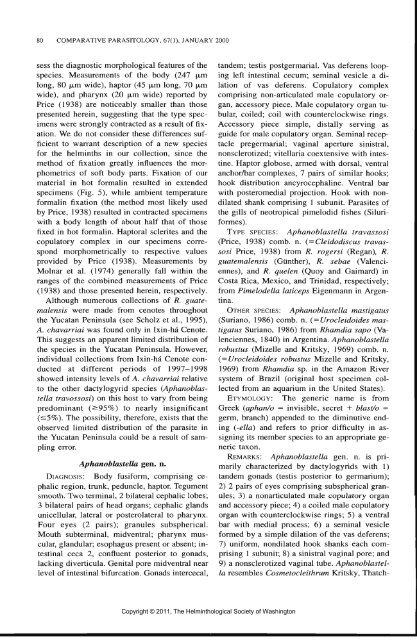Comparative Parasitology 67(1) 2000 - Peru State College
Comparative Parasitology 67(1) 2000 - Peru State College
Comparative Parasitology 67(1) 2000 - Peru State College
You also want an ePaper? Increase the reach of your titles
YUMPU automatically turns print PDFs into web optimized ePapers that Google loves.
COMPARATIVE PARASITOLOGY, <strong>67</strong>(1), JANUARY <strong>2000</strong><br />
sess the diagnostic morphological features of the<br />
species. Measurements of the body (247 (Jim<br />
long, 80 (Jim wide), haptor (45 u-m long, 70 (xm<br />
wide), and pharynx (20 [Am wide) reported by<br />
Price (1938) are noticeably smaller than those<br />
presented herein, suggesting that the type specimens<br />
were strongly contracted as a result of fixation.<br />
We do not consider these differences sufficient<br />
to warrant description of a new species<br />
for the helminths in our collection, since the<br />
method of fixation greatly influences the morphometrics<br />
of soft body parts. Fixation of our<br />
material in hot formalin resulted in extended<br />
specimens (Fig. 5), while ambient temperature<br />
formalin fixation (the method most likely used<br />
by Price, 1938) resulted in contracted specimens<br />
with a body length of about half that of those<br />
fixed in hot formalin. Haptoral sclerites and the<br />
copulatory complex in our specimens correspond<br />
morphometrically to respective values<br />
provided by Price (1938). Measurements by<br />
Molnar et al. (1974) generally fall within the<br />
ranges of the combined measurements of Price<br />
(1938) and those presented herein, respectively.<br />
Although numerous collections of R. guatemalensis<br />
were made from cenotes throughout<br />
the Yucatan Peninsula (see Scholz et al., 1995),<br />
A. chavarriai was found only in Ixin-ha Cenote.<br />
This suggests an apparent limited distribution of<br />
the species in the Yucatan Peninsula. However,<br />
individual collections from Ixin-ha Cenote conducted<br />
at different periods of 1997-1998<br />
showed intensity levels of A. chavarriai relative<br />
to the other dactylogyrid species (Aphanoblastella<br />
travossosi) on this host to vary from being<br />
predominant (^95%) to nearly insignificant<br />
(
















